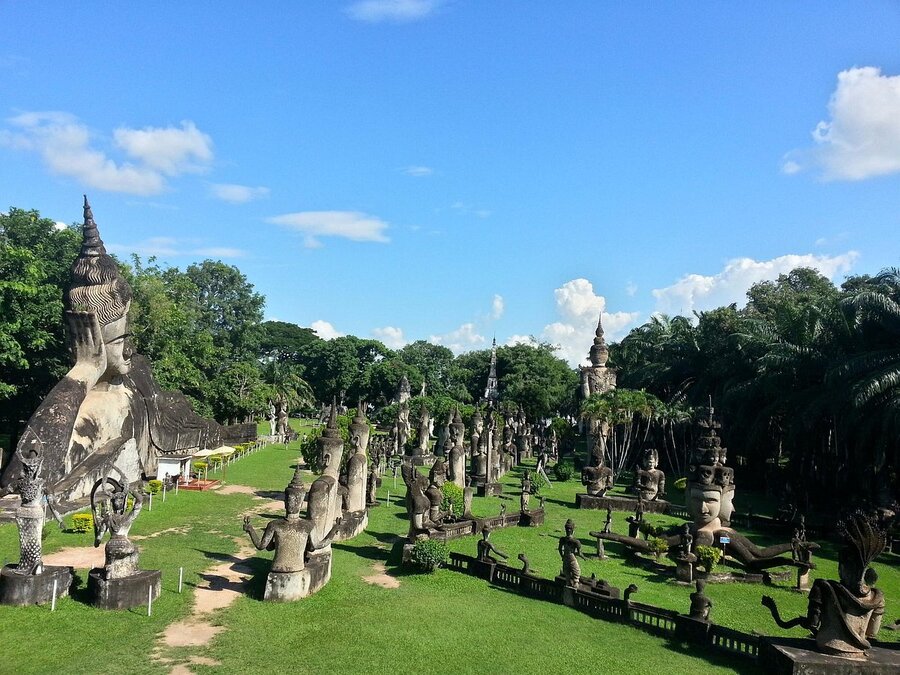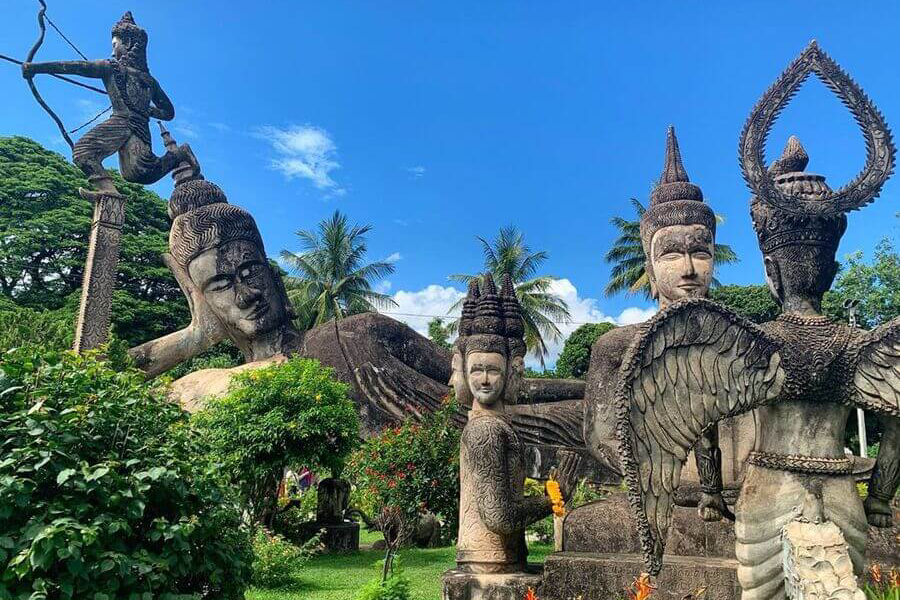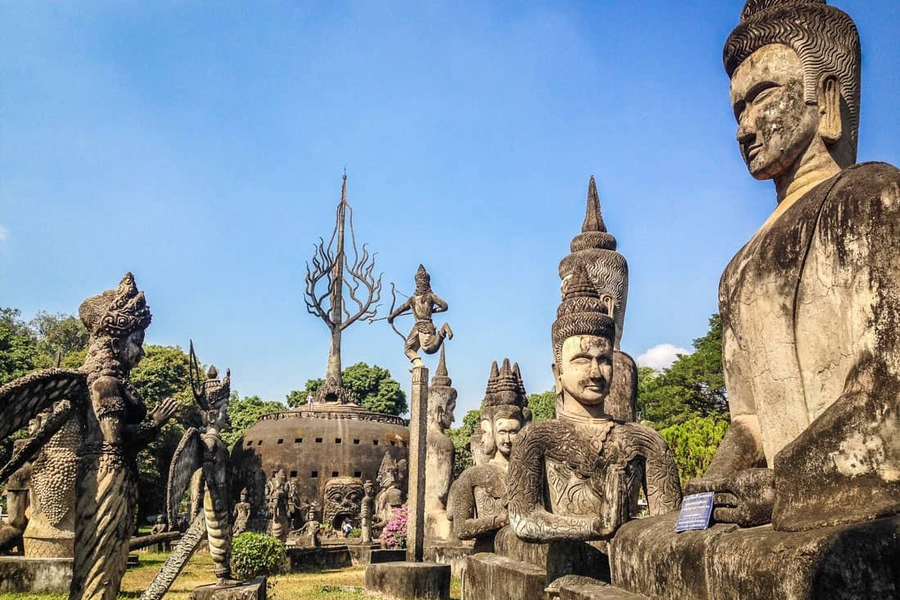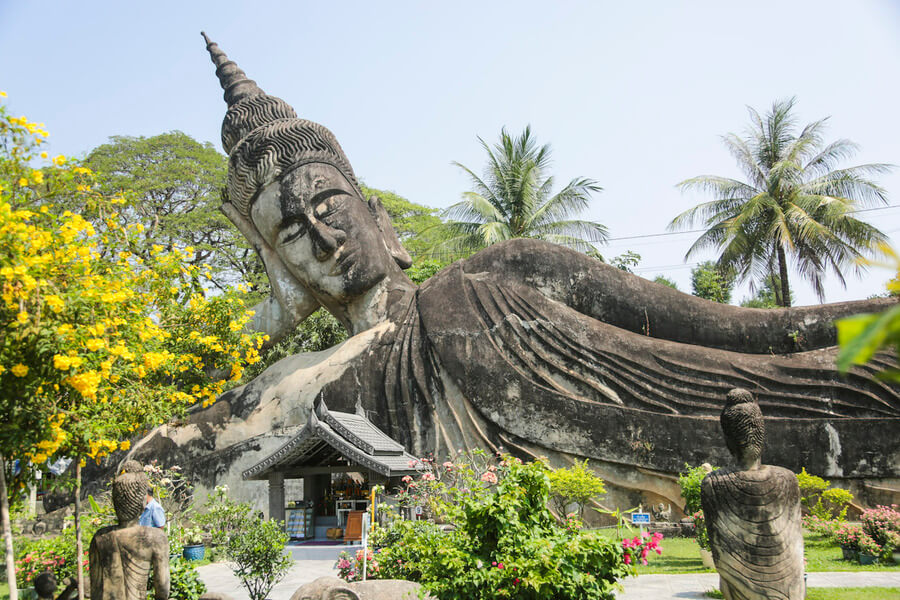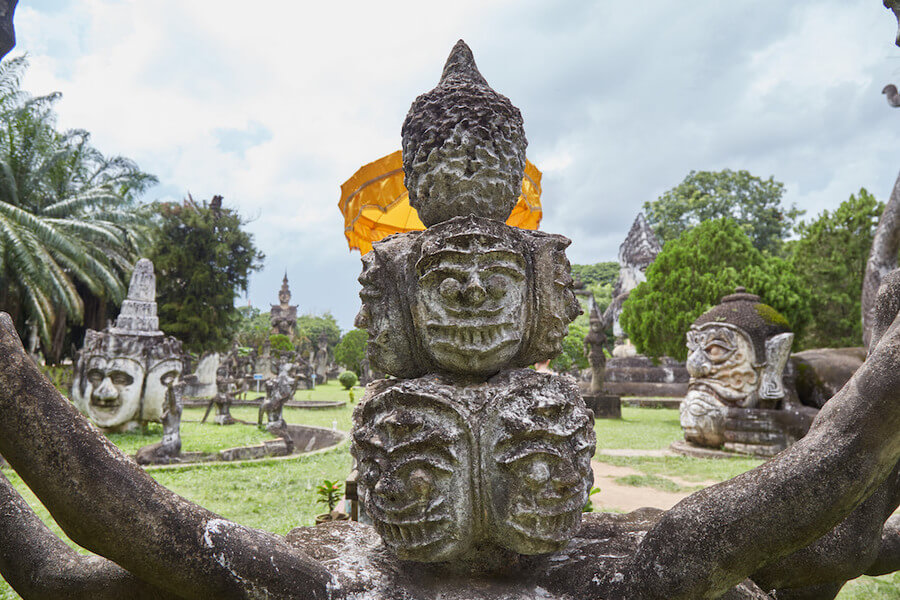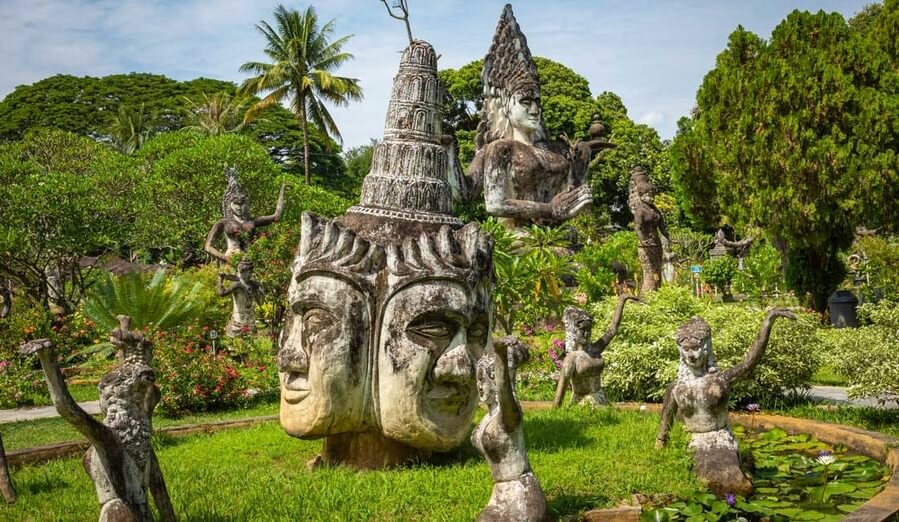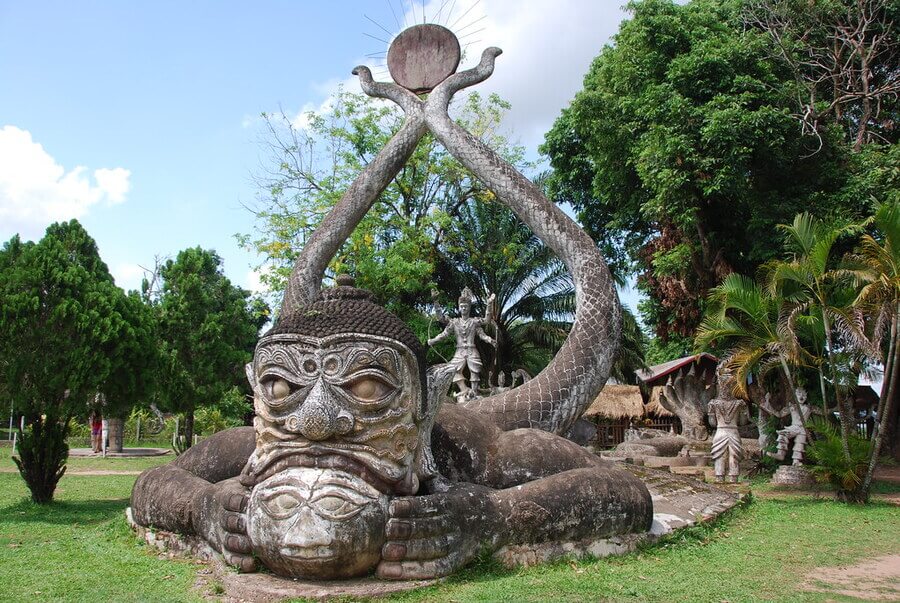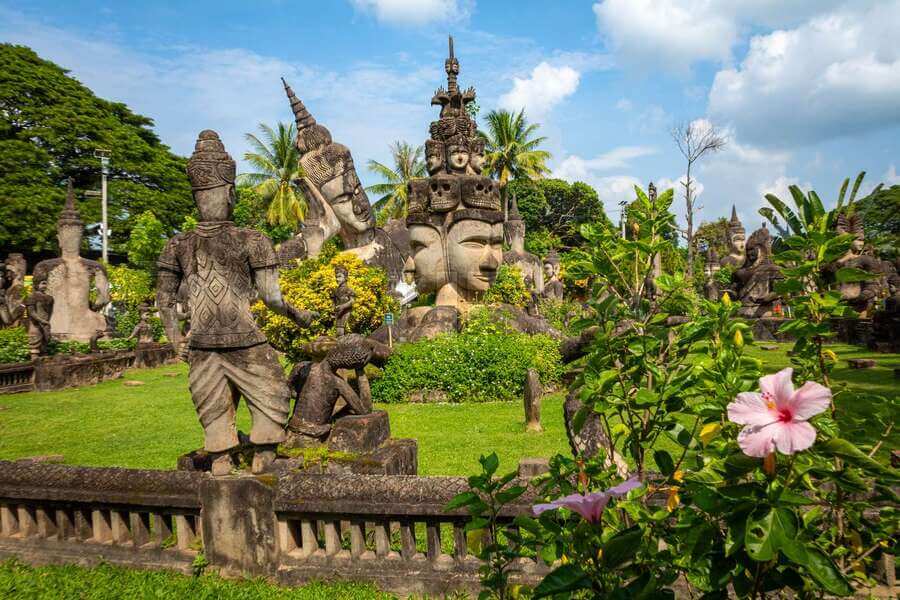Buddha Park, also known as Xieng Khuan, is an enchanting and spiritually significant attraction located about 25 kilometers southeast of Vientiane, the capital city of Laos. This unique park is a testament to the creative vision of a single man, Luang Pu Bunleua Sulilat, who conceptualized and brought to life a mesmerizing blend of Buddhist and Hindu religious art, folklore, and cultural symbolism. As visitors on Laos tours explore the park's grounds, they encounter a mesmerizing array of deities, demons, and mythological creatures drawn from both belief systems.
The Origin Story of Buddha Park
Luang Pu Bunleua Sulilat was born in 1905 in Laos, a country steeped in Buddhist traditions. His early life followed a conventional path as he embraced Buddhism and became a monk. However, his spiritual journey took an unconventional turn when he began to receive what he described as divine visions and revelations.
In the late 1950s, Luang Pu Bunleua Sulilat claimed to have received a divine calling. He asserted that in a series of vivid dreams and mystical experiences, he was urged to build a park that would transcend religious boundaries. These revelations convinced him that he had a divine mission to create a space where people from all walks of life could find spiritual solace and reflection.
In 1958, Luang Pu Bunleua Sulilat began transforming his divine visions into concrete reality. Despite the prevailing use of stone for monumental sculptures during that era, he chose concrete as his primary medium for its practicality and malleability. This choice allowed him greater artistic freedom in crafting intricate and expressive statues.
Over nearly two decades, Luang Pu Bunleua Sulilat painstakingly crafted sculptures and structures that would later populate Buddha Park. His dedication to detail and profound spirituality shine through in every piece, from the imposing statues of Buddha to the myriad of mythological figures.
Buddha Park in Vientiane: A Spiritual Oasis in Southeast Asia
The park is strategically positioned along the banks of the majestic Mekong River, offering visitors serene and picturesque views of the river's tranquil waters.This location in the Vientiane Province makes Buddha Park easily accessible to tourists and locals alike. Visitors can embark on a short journey from the bustling city center of Vientiane to reach the park's serene environment in a matter of minutes. This convenience has contributed to the park's popularity as a day-trip destination for those exploring the capital city.
In addition to its proximity to Vientiane, Buddha Park's location also places it near the Thai-Lao border. This geographic position has influenced the park's unique blend of cultural influences, as it serves as a meeting point for diverse beliefs and traditions. It's a place where visitors can witness the harmonious coexistence of various spiritual and artistic expressions.
The riverside setting of Buddha Park adds to its charm. With the Mekong River flowing nearby, visitors can enjoy tranquil views of the river while exploring the park's artistic and spiritual wonders. The combination of natural beauty, cultural richness, and artistic marvels makes Buddha Park a distinctive and easily accessible destination in Laos.
Buddha Park: 7 Spiritual Sculptures, Explore Now!
1. Monumental Statues
The park's monumental statues serve as guardians of Lao traditions and spiritual heritage. You'll find images of various gods, goddesses, and mythical creatures, all intricately crafted to represent different aspects of Buddhist beliefs. These sculptures stand as a testament to the profound reverence the Lao people have for their spiritual and cultural roots.
The artistic craftsmanship on display is nothing short of extraordinary. The attention to detail, the precision of the carvings, and the sheer size of these statues are a testament to the skill and dedication of the artisans who brought them to life. The intricate facial expressions, graceful postures, and elaborate designs make these statues true works of art.
2. Reclining Buddha
In the enchanting landscape of Laos, within the serene grounds of Buddha Park, a profound symbol of tranquility and spirituality awaits - the awe-inspiring Reclining Buddha. Measuring over 40 meters in length, this monumental masterpiece is not just a sculpture but a profound representation of spiritual wisdom and artistic craftsmanship.
The Reclining Buddha in Buddha Park, Laos, exudes a sense of serenity and grace. Its sheer size and meticulous craftsmanship make it a symbol of reverence for the Buddhist faith and a true work of art. The gentle smile on the Buddha's face, the delicate details of the figure, and the peaceful repose in the reclining posture all symbolize the wisdom and tranquility that Buddhism imparts. It stands as a testament to the enduring influence of Buddhism in the region.
Its reclining posture represents the Buddha's passage into Nirvana, signifying the ultimate goal of liberation from suffering and rebirth. The depiction of this transition from life to the state of Nirvana encourages visitors to contemplate the impermanence of life and the pursuit of inner peace. It is an invitation to reflect on one's spiritual journey, the quest for balance, and the importance of finding inner harmony in a world filled with chaos and distractions.
3. The Wheel of Dharma
The Wheel of Dharma, or Dharmachakra, is a symbolic representation of the Buddhist path to enlightenment. It takes the form of a circular wheel with eight spokes, each of which carries a significant meaning. These eight spokes represent the Eightfold Path, a fundamental concept in Buddhism that guides practitioners toward a life of moral and mental development.
The circular form of the wheel represents the cyclical nature of existence, emphasizing the continuous journey of self-improvement and self-discovery.
Each spoke of the wheel corresponds to one of the Eightfold Path's guiding principles: right view, right intention, right speech, right action, right livelihood, right effort, right mindfulness, and right concentration. These principles form the foundation of Buddhist practice, and the Wheel of Dharma stands as a powerful reminder of their importance.
4. Demon Guardians
The awe-inspiring Demon Guardians, with their imposing and intricate presence, are are symbolic protectors of spiritual treasures and powerful representations of the ongoing battle against inner demons.
In the world of Buddhist teachings, they symbolize the relentless struggle against the inner demons that obstruct the path to spiritual enlightenment. Their fierce and awe-inspiring appearances serve as reminders of the challenges one must overcome to achieve inner peace, wisdom, and ultimately, Nirvana.
The Demon Guardians not only represent the struggle against inner turmoil but also serve as protectors of Buddhist teachings and spiritual heritage. Their presence adds a unique and meaningful dimension to the spiritual and artistic tapestry of the region, making them an essential part of the enriching journey through this remarkable destination.
5. Serene Bodhisattvas
Within the spiritual sanctuary of Buddha Park in Laos, one encounters an array of serene Bodhisattva sculptures, each representing an icon of compassion and enlightenment.
Bodhisattvas are revered figures in Buddhism known for their unwavering commitment to alleviating the suffering of all sentient beings. These sculptures often depict Bodhisattvas in graceful and serene poses, reflecting their profound spiritual wisdom.
6. Mythical Beasts
The mythical beasts of Buddha Park are inspired by ancient legends and mythologies. Each of these mythical creatures carries its own symbolic significance and plays a unique role in the spiritual narrative.
Their presence adds depth and character to Buddha Park, and they inspire all who visit to appreciate the cultural richness and the enduring legacy of mythology in Laos. These mythical creatures serve as a testament to the profound and multifaceted tapestry of Lao culture.
7. Intricate Wall Carvings
The wall carvings of Buddha Park are a testament to the skill and craftsmanship of the artisans who created them. Each carving carries a unique message and serves as a visual representation of the profound teachings of Buddhism. They are like chapters in a grand spiritual storybook, inviting individuals to contemplate the virtues of compassion, wisdom, and the path to inner peace.
In the tranquil and contemplative setting of Buddha Park, the intricate wall carvings serve as gateways to a world where art, spirituality, and culture converge.
Opening Hours and Ticket Prices at Buddha Park
Opening Hours
Buddha Park welcomes visitors throughout the year, providing an opportunity to explore its unique sculptures and serene ambiance. The opening hours are as follows:
Monday to Saturday: 8:00 AM - 5:00 PM
Sunday: 10:00 AM - 3:30 PM
Ticket Prices
Adults: The standard admission fee for adults is 10,000 Lao Kip, which is roughly equivalent to 1.10 USD.
Children: Children under the age of 12 usually enjoy a discounted rate, with ticket prices ranging from 5,000 Lao Kip to free entry, depending on their age and local policies. It's best to inquire about specific child ticket prices when you arrive.
Photography Fee: If you plan to take photos within the park, there may be a separate photography fee. This fee is typically nominal and is often around 3,000 Lao Kip (about 0.33 USD).

